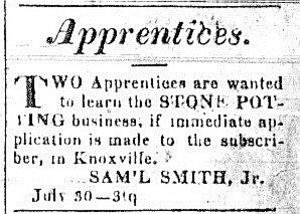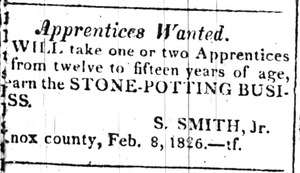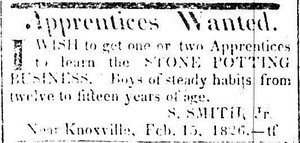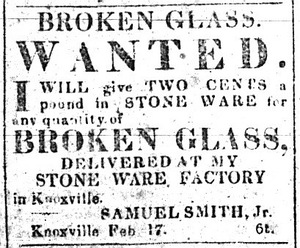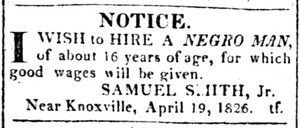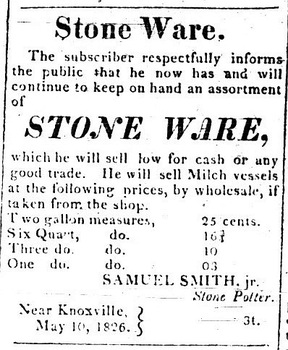Samuel Smith Pottery
Carole C. Wahler
The Samuel Smith Pottery in Knoxville was not only the earliest stoneware pottery in Tennessee, it was one of the earliest in the South. The usual utilitarian forms were produced. The most distinctive form is a tall jar made to hold a drop-in lid, with rather small lug handles placed high on the shoulder. This particular jar form is distinctive and unfamiliar to the writer. The pots are coated both on the interior and the exterior with an iron wash that at times appears more like a slip. “Smith, Jr.” is stamped either on a side or on the bottom. Jr. is spelled with an “I” and the “R” is in superscript.
Other known early stoneware production in the South was in Alexandria D.C., c. 1815, Richmond, VA c. 1811, Wheeling VA, c. 1817, and Fayetteville, N.C., c. 1819. Of these, the writer is only aware of iron wash being used in Alexandria and Fayetteville. Iron wash was commonly used in Europe and in the Northeast.
The 1820 Federal Non-Population Schedule for East Tennessee lists a Samuel Smith as a “Stone Ware” manufacturer. Thirteen “kills” of ware were reported to have been produced. Twelve kilns were stoneware and one kiln “in different Kind of Ware”. The answers to the census taker’s questions suggest that this latter kiln may have been brick, as no mention is made of lead glazing materials. Two men were employed.
The only published reference on Tennessee pottery making listed Smith as being born in North Carolina in 1800. This, however, created a problem for the student of pottery. Where did he learn to pot stoneware prior to 1819? He had to possess specific skills involved in “stone potting” and the ability to recognize suitable clay.
Dr. Charles Faulkner1 initiated research on the Smith Pottery. He documented land transactions and located an 1823 marriage of Samuel Smith, Jr. to Oney Kearns . He also learned that Samuel was born in the Canton of Aargua, Switzerland, came to Knoxville in 1819 and eventually moved his family to Texas. Learning about Switzerland helped. That explained where Smith had learned stoneware potting and it explained the use of iron wash. However, the question as to how or why he chose Knoxville presented itself; especially since it appeared that he moved more or less directly to Knoxville.
When descendants in Texas were eventually located they verified that he was born in Switzerland in 1800 and arrived in Knoxville in 1819. (The birth date of 1800 was coincidentally correct.) However, the family maintained that he was never a potter. The only choice left was to conduct an exhaustive search of Knox County records for Samuel Smiths. All existing census records, tax records, court minutes and deeds were scrutinized.
Steve Rogers2 located Smith’s naturalization in Knoxville in 1827, which verified information obtained from the family. He also found him in the Knox County tax records of 1826-1831.
Newspaper advertisements for the Smith Pottery have been found for the years 1822-26. The following are examples.
The location of his pottery in the 1822 advertisement is Knoxville; however, by 1826 the ads state “Near Knoxville”. The exception to this being an 1826 ad for Broken Glass which is an exact copy of the 1822 advertisement. The location of the pottery in 1819 and 1820 has not been determined.
In 1821 Samuel purchased 100 acres in Knoxville from Charles L. Love. It is possible that he leased the land prior to this transaction.
In 1823 he purchased 57 acres from James Kennedy Senior on Second Creek in Knoxville. The deed reads " . . . that the said James Kennedy Senr. for and in consideration of the sum of five hundred dollars payable in stone ware at the present amount wholesale prices the one half to be delivered in the Beginning of next September and the remainder in the Beginning of March one thousand eight hundred and twenty five . . . "
In 1826 Samuel purchased two parcels of 20 acres each from Hugh Dunlap. All three of these land purchases appear to adjoin each other.
The 1820 census records for East Tennessee were lost. Fortunately, Knox County tax records exist for the years 1822-1831. These records provide a cross reference with the above deeds and subsequent sales.
The 1830 Knox County census lists Samuel Smith with:
2 males under 5 years
1 male 5-10
2 males 15-20 [likely to be apprentices]
1 male 20-30
1 female under 5
1 female 20-30
1 male slave 24-36.
On October 9, 1830 Smith sold both of his 20 acre tracts and his 57 acres on Second Creek to John Webb. Within a short period of time he purchased 200 acres in Anderson County from John and Polly Ann McAdoo.
In 1832 Samuel sold his last parcel of Knox County land, 100 acres to Isaac Johnson. The deed reads " . . . between Samuel Smith of the County of Anderson . . . "
No other Samuel Smith could be located in Anderson County at that time. He appears in the 1840 Anderson County census with:
2 males 10-15
1 male 15-20
1 male 30-40
2 females under 5
2 females 5-10
1 female 10-15
1 female 30-40
1 male slave 36-55
3 persons engaged in agriculture
There is no evidence that he ever potted again after leaving Knox County. In fact, there is no indication that utilitarian pottery was ever produced in Anderson County.
Smith family historians say that he left Tennessee in1849 with his wife and all of his children, except one married daughter. The Smiths founded a town in Smith County Texas and named it Knoxville. One son became a silversmith, another a blacksmith, another owned a sawmill, gin and grist mill while a fourth worked for the railroad. There is no mention anywhere of a pottery shop.
Historians tell us that the 1830s were difficult times financially in Knoxville, that the area was suffering what today would be called a depression. This might explain Smith leaving Knox County or even Tennessee, but it does not explain never potting again.
In summary, all the archival evidence points to only one Samuel Smith, Jr.; the potter, the man who married Oney Kearns, the man who bought and sold land in Knox County and the man who moved his family first to Anderson County and then to Texas. He died in Cherokee County, Texas in 1873. His birth and apprenticeship in Switzerland explain his knowledge of the stoneware potting business in 1819. Also it can explain the fact that at least one of his jar forms is not easily recognized as being similar to other wares made in the United States.
What has not been answered is why he chose Knoxville, Tennessee in the first place. His arrival in 1819 was at least 30 years before Knoxville’s Swiss Immigration. Also unanswered is why he stopped potting by 1832, apparently never to pot again.
1 Personal communication, Dr. Charles H. Faulkner, Professor, University of Tennessee, Department of Anthropology.
2 Personal communication, S. T. Rogers, Tennessee Historical Commission, Department of Environment and Conservation.
Myers, Suzita. The Potters’ Art, Salt-Glazed Stoneware of Nineteenth-Century Alexandria. Alexandria Papers in Urban Archaeology, Mus. Series, No. 1, 1983.
Rauschenberg, Bradford L. “B. DuVal and Co/Richmond: A Newly Discovered Pottery”. The Pottery Collectors Newsletter, 8(4):26-38, 1978.
Scarborough, Quincy, Jr. North Carolina Decorated Stoneware: The Webster School of Folk Potters. The Scarborough Press, Fayetteville, N.C., 1986.
Smith, S.D., and Rogers, S.T. A Survey of Historic Pottery Making in Tennessee, Nashville: Research Series, No. 3, Division of Archaeology, Tennessee Dept. of Conservation, 1979.
Zug, Charles G., III. Turners & Burners: The Folk Potters of North Carolina. Chapel Hill: University of North Carolina Press, 1986.
Note: The background image pots are both stamped SMITH.IR
This article was originally published on www.cwahlerantiques.com
October 11, 2012
